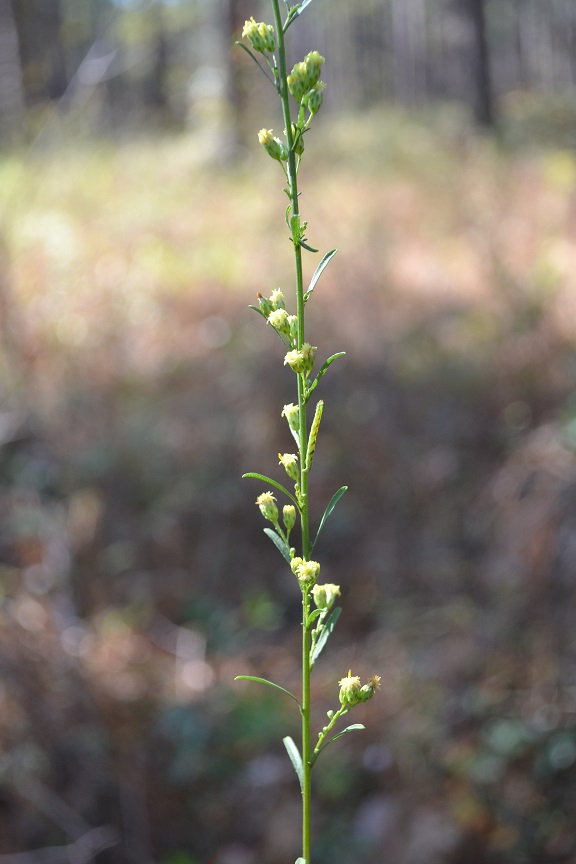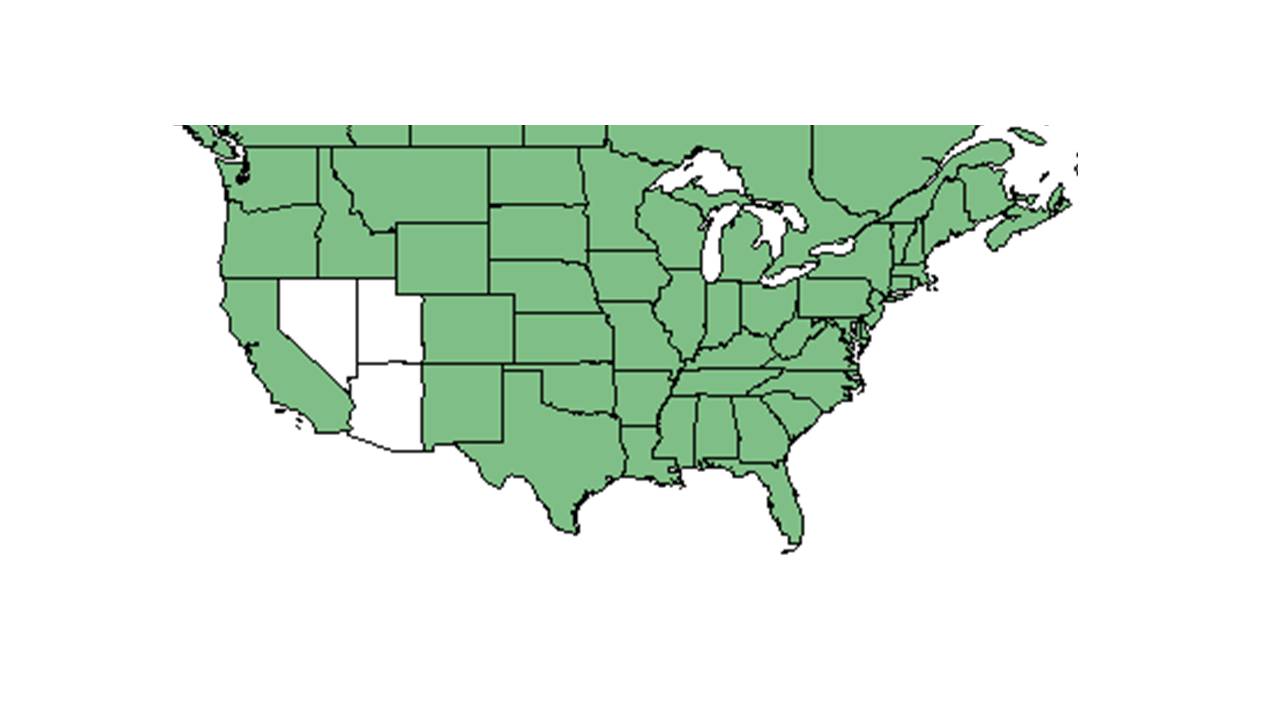Difference between revisions of "Erigeron strigosus"
(→Distribution) |
|||
| Line 33: | Line 33: | ||
==Ecology== | ==Ecology== | ||
===Habitat=== <!--Natural communities, human disturbed habitats, topography, hydrology, soils, light, fire regime requirements for removal of competition, etc.--> | ===Habitat=== <!--Natural communities, human disturbed habitats, topography, hydrology, soils, light, fire regime requirements for removal of competition, etc.--> | ||
| − | In the Coastal Plain, ''E. strigosus'' can occur in upland old fields, sandy floodplains, turkey oak forests, lake shores, sandhill scrub oak-wiregrass communities, open oak woods, boggy slopes of longleaf pine savannas, and open limestone glades. In human disturbed areas it has been found along sandy roadsides, vacant lots, a disturbed sandhill growing with planted ''Pinus palustris'' and disturbed longleaf pine restoration sites. <ref name=fsu> Florida State University Robert K. Godfrey Herbarium database. URL: http://herbarium.bio.fsu.edu. Last accessed: October 2015. Collectors: Loran C. Anderson, Wilson Baker, Andre F. Clewell, R.F. Doren, Patricia Elliot, Richard Gaskalla, J.P. Gillespie, R. K. Godfrey, H.E. Grelen, Brenda Herring, Don Herring, E.M. Hodgson, C. Jackson, Ann F. Johnson, J.M. Kane, Gary R. Knight, R. Komarek, R. Kral, Richard Mitchell, R. A. Norris, Gwynn W. Ramsey, Paul L. Redfearn Jr. , Bian Tan, L.B. Trott, B. L. Turner. States and Counties: Alabama: Limestone. Florida: Calhoun, Columbia, Franklin, Gadsden, Hamilton, Leon, Liberty, Jackson, Jefferson, Madison, Marion, Nassau, Okaloosa, Polk, Putnam, Suwannee, Union, Wakulla. Georgia: Grady, Thomas. Louisiana: Caldwell. Compiled by Tall Timbers Research Station and Land Conservancy.</ref> Soils include sand, sandy clay, loamy sand and sandy loam. <ref name=fsu/> Associated species include ''Liatris, Panicum, Leptoloma cognata, Baptisia megacarpa, Festuca, Piptochaetium, Verbena, Pinus palustris, Hymenopappus scabiosaeus, Phlox floridana, Stillingia sylvatica, Asimina longifolia var. spathulata, Lactuca graminifolia, Stylosanthes biflora, Erigeron strigosa, Baptisia lanceolata, Hedyotis crassifolia, Pterocauloon undulatum, Asclepias humistrata, Quercus hemisphaerica, Rhynchospora divergens'', and ''Allium canadense''. <ref name=fsu/> | + | ''E. strigosus'' var. ''calcicola'' can be found in limestone glades, var. ''dolomiticola'' can be found in calcareous Ketona glades, var. ''septentrionalis'' can be found in roadsides and other disturbed areas, and var. ''strigosus'' can be found in open woodlands as well as roadsides and other disturbed areas.<ref name= "Weakley"/> In the Coastal Plain, ''E. strigosus'' can occur in upland old fields, sandy floodplains, turkey oak forests, lake shores, sandhill scrub oak-wiregrass communities, open oak woods, boggy slopes of longleaf pine savannas, and open limestone glades. In human disturbed areas it has been found along sandy roadsides, vacant lots, a disturbed sandhill growing with planted ''Pinus palustris'' and disturbed longleaf pine restoration sites. <ref name=fsu> Florida State University Robert K. Godfrey Herbarium database. URL: http://herbarium.bio.fsu.edu. Last accessed: October 2015. Collectors: Loran C. Anderson, Wilson Baker, Andre F. Clewell, R.F. Doren, Patricia Elliot, Richard Gaskalla, J.P. Gillespie, R. K. Godfrey, H.E. Grelen, Brenda Herring, Don Herring, E.M. Hodgson, C. Jackson, Ann F. Johnson, J.M. Kane, Gary R. Knight, R. Komarek, R. Kral, Richard Mitchell, R. A. Norris, Gwynn W. Ramsey, Paul L. Redfearn Jr. , Bian Tan, L.B. Trott, B. L. Turner. States and Counties: Alabama: Limestone. Florida: Calhoun, Columbia, Franklin, Gadsden, Hamilton, Leon, Liberty, Jackson, Jefferson, Madison, Marion, Nassau, Okaloosa, Polk, Putnam, Suwannee, Union, Wakulla. Georgia: Grady, Thomas. Louisiana: Caldwell. Compiled by Tall Timbers Research Station and Land Conservancy.</ref> Soils include sand, sandy clay, loamy sand and sandy loam. <ref name=fsu/> |
| + | |||
| + | Associated species include ''Liatris, Panicum, Leptoloma cognata, Baptisia megacarpa, Festuca, Piptochaetium, Verbena, Pinus palustris, Hymenopappus scabiosaeus, Phlox floridana, Stillingia sylvatica, Asimina longifolia var. spathulata, Lactuca graminifolia, Stylosanthes biflora, Erigeron strigosa, Baptisia lanceolata, Hedyotis crassifolia, Pterocauloon undulatum, Asclepias humistrata, Quercus hemisphaerica, Rhynchospora divergens'', and ''Allium canadense''. <ref name=fsu/> | ||
| + | |||
===Phenology=== <!--Timing off flowering, fruiting, seed dispersal, and environmental triggers. Cite PanFlora website if appropriate: http://www.gilnelson.com/PanFlora/ --> | ===Phenology=== <!--Timing off flowering, fruiting, seed dispersal, and environmental triggers. Cite PanFlora website if appropriate: http://www.gilnelson.com/PanFlora/ --> | ||
''E. strigosus'' has been observed flowering in February through October with peak inflorescence in May.<ref>Nelson, G. [http://www.gilnelson.com/ PanFlora]: Plant data for the eastern United States with emphasis on the Southeastern Coastal Plains, Florida, and the Florida Panhandle. www.gilnelson.com/PanFlora/ Accessed: 9 DEC 2016</ref><ref name=fsu/> | ''E. strigosus'' has been observed flowering in February through October with peak inflorescence in May.<ref>Nelson, G. [http://www.gilnelson.com/ PanFlora]: Plant data for the eastern United States with emphasis on the Southeastern Coastal Plains, Florida, and the Florida Panhandle. www.gilnelson.com/PanFlora/ Accessed: 9 DEC 2016</ref><ref name=fsu/> | ||
Revision as of 09:03, 9 May 2019
| Erigeron strigosus | |
|---|---|

| |
| Photo taken by Kevin Robertson | |
| Scientific classification | |
| Kingdom: | Plantae |
| Division: | Magnoliophyta - Flowering plants |
| Class: | Magnoliopsida – Dicotyledons |
| Order: | Asterales |
| Family: | Asteraceae ⁄ Compositae |
| Genus: | Erigeron |
| Species: | E. strigosus |
| Binomial name | |
| Erigeron strigosus Muhl. ex Willd. | |

| |
| Natural range of Erigeron strigosus from USDA NRCS Plants Database. | |
Common names: Prairie fleabane; Common eastern fleabane
Contents
Taxonomic notes
Synonyms: E. strigosus var. beyrichii (Fisch. & C.A. Mey.) Torr. & A. Gray ex A. Gray; E. ramosus (Walter) Britton, Sterns, & Poggenburg
Varieties: Erigeron strigosus Muhlenberg ex Wildenow var. calcicola J. Allison; Erigeron strigosus Muhlenberg ex Wildenow var. dolomiticola J. Allison; Erigeron strigosus Muhlenberg ex Willdenow var. septentrionalis (Fernald & Wiegand) Fernald; Erigeron strigosus Muhlenberg ex Wildenow var. strigosus
Description
A description of Erigeron strigosus is provided in The Flora of North America.
Distribution
Generally, E. strigosus can be found across the United States and Canada in all provinces except the northern provinces, and all states but Alaska, Hawaii, Nevada, Utah, and Arizona.[1] E. strigosus var. calcicola is found in the central basin of Tennessee, northwest Georgia, and northern Alabama. E. strigosus var. dolomiticola is endemic to Bibb county in Alabama. E. strigosus var. septentrionalis is scattered across northern North America, south to New York, Tennessee, Arkansas, Oklahoma, Wyoming, and California. Lastly E. strigosus var. strigosus is distributed from Nova Scotia west to Washington state, and south to central peninsular Florida as well as Texas.[2]
Ecology
Habitat
E. strigosus var. calcicola can be found in limestone glades, var. dolomiticola can be found in calcareous Ketona glades, var. septentrionalis can be found in roadsides and other disturbed areas, and var. strigosus can be found in open woodlands as well as roadsides and other disturbed areas.[2] In the Coastal Plain, E. strigosus can occur in upland old fields, sandy floodplains, turkey oak forests, lake shores, sandhill scrub oak-wiregrass communities, open oak woods, boggy slopes of longleaf pine savannas, and open limestone glades. In human disturbed areas it has been found along sandy roadsides, vacant lots, a disturbed sandhill growing with planted Pinus palustris and disturbed longleaf pine restoration sites. [3] Soils include sand, sandy clay, loamy sand and sandy loam. [3]
Associated species include Liatris, Panicum, Leptoloma cognata, Baptisia megacarpa, Festuca, Piptochaetium, Verbena, Pinus palustris, Hymenopappus scabiosaeus, Phlox floridana, Stillingia sylvatica, Asimina longifolia var. spathulata, Lactuca graminifolia, Stylosanthes biflora, Erigeron strigosa, Baptisia lanceolata, Hedyotis crassifolia, Pterocauloon undulatum, Asclepias humistrata, Quercus hemisphaerica, Rhynchospora divergens, and Allium canadense. [3]
Phenology
E. strigosus has been observed flowering in February through October with peak inflorescence in May.[4][3]
Seed dispersal
This species is thought to be dispersed by wind. [5]
Pollination
The following Hymenoptera families and species were observed visiting flowers of Erigeron strigosus at Archbold Biological Station. [6]
Halictidae: Agapostemon splendens, Augochlorella aurata, Halictus poeyi, Lasioglossum placidensis
Conservation and management
Cultivation and restoration
Photo Gallery
References and notes
- ↑ USDA, NRCS. (2016). The PLANTS Database (http://plants.usda.gov, 8 May 2019). National Plant Data Team, Greensboro, NC 27401-4901 USA.
- ↑ 2.0 2.1 Cite error: Invalid
<ref>tag; no text was provided for refs namedWeakley - ↑ 3.0 3.1 3.2 3.3 Florida State University Robert K. Godfrey Herbarium database. URL: http://herbarium.bio.fsu.edu. Last accessed: October 2015. Collectors: Loran C. Anderson, Wilson Baker, Andre F. Clewell, R.F. Doren, Patricia Elliot, Richard Gaskalla, J.P. Gillespie, R. K. Godfrey, H.E. Grelen, Brenda Herring, Don Herring, E.M. Hodgson, C. Jackson, Ann F. Johnson, J.M. Kane, Gary R. Knight, R. Komarek, R. Kral, Richard Mitchell, R. A. Norris, Gwynn W. Ramsey, Paul L. Redfearn Jr. , Bian Tan, L.B. Trott, B. L. Turner. States and Counties: Alabama: Limestone. Florida: Calhoun, Columbia, Franklin, Gadsden, Hamilton, Leon, Liberty, Jackson, Jefferson, Madison, Marion, Nassau, Okaloosa, Polk, Putnam, Suwannee, Union, Wakulla. Georgia: Grady, Thomas. Louisiana: Caldwell. Compiled by Tall Timbers Research Station and Land Conservancy.
- ↑ Nelson, G. PanFlora: Plant data for the eastern United States with emphasis on the Southeastern Coastal Plains, Florida, and the Florida Panhandle. www.gilnelson.com/PanFlora/ Accessed: 9 DEC 2016
- ↑ Kirkman, L. Katherine. Unpublished database of seed dispersal mode of plants found in Coastal Plain longleaf pine-grasslands of the Jones Ecological Research Center, Georgia.
- ↑ Deyrup, M.A. and N.D. 2015. Database of observations of Hymenoptera visitations to flowers of plants on Archbold Biological Station, Florida, USA.